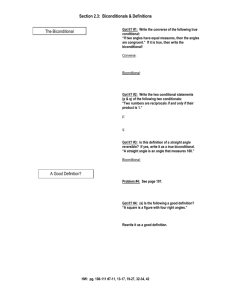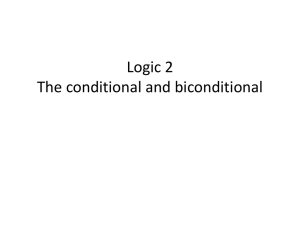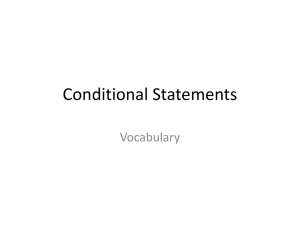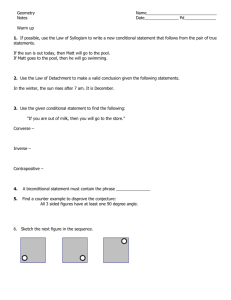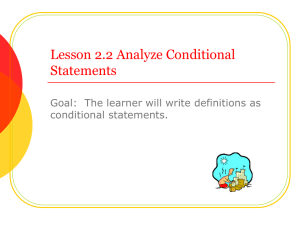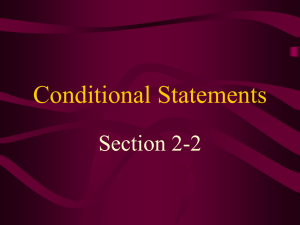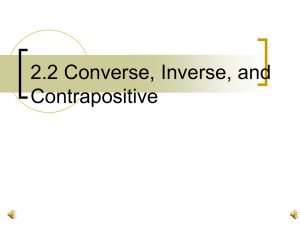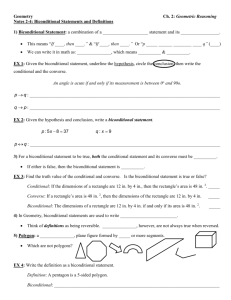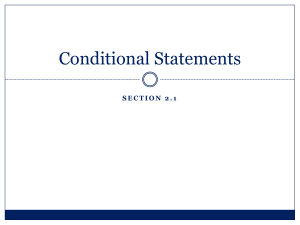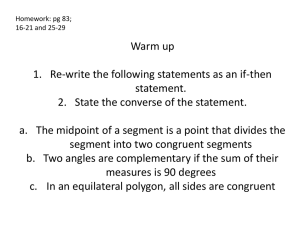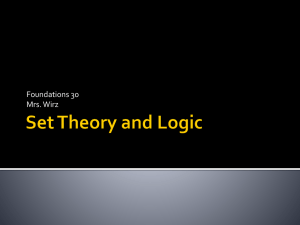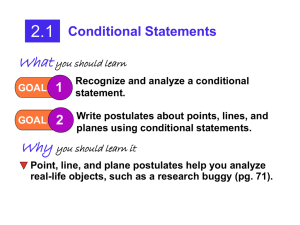If-Then Statements and Postulates
advertisement
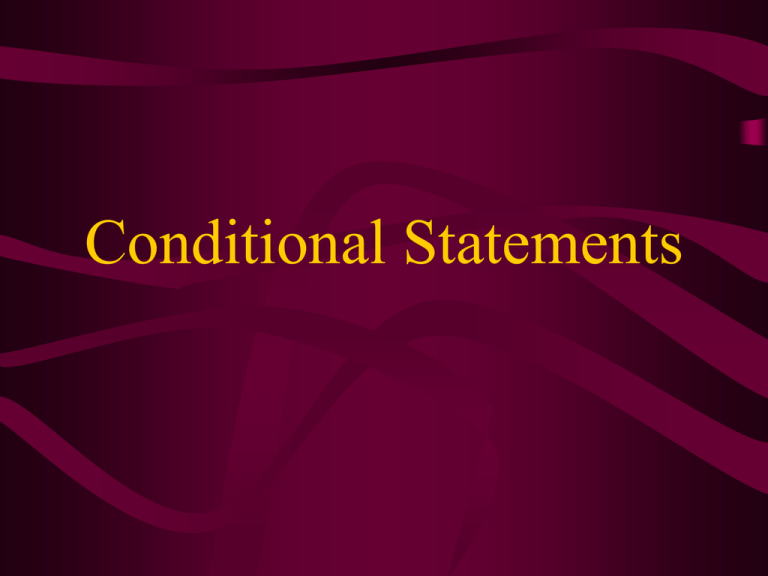
Conditional Statements Conditional Statements If-then statements are called conditional statements. The portion of the sentence following if is called the hypothesis. The part following then is called the conclusion. p q (If p, then q) p q If it is an apple, then it is a fruit. Hypothesis – It is an apple. Conclusion – It is a fruit. Converse q p The converse statement is formed by switching the hypothesis and conclusion. If it is an apple, then it is a fruit. Converse: If it is a fruit, then it is an apple. The converse may be true or false. negation – the denial of a statement Ex. “An angle is obtuse.” Negation – “An angle is not obtuse.” Inverse ~p ~q An inverse statement can be formed by negating both the hypothesis and conclusion. If it is an apple, then it is a fruit. Inverse: If it is not an apple, then it is not a fruit. The inverse may be true or false. Contrapositive ~q ~p A contrapositive is formed by negating the hypothesis and conclusion of the converse. If it is an apple, then it is a fruit. Contrapositive: If it is not a fruit, then it is not an apple. The contrapositive of a true conditional is true and of a false conditional is false. If you double the radius of a circle, then you will know the length of the diameter. Write the given statements in symbolic form. • If you don’t know the length of the diameter, Contrapositive then you haven’t doubled the radius. • If you don’t double the radius of a circle, Inverse then you will not know the length of the diameter. Invalid • If you know the length of the diameter, then you haven’t doubled the radius. • If you know the length of the diameter, Converse then you have doubled the radius. • Select the statement(s) above that are not valid. • Identify the converse, inverse, and contrapositive. A biconditional statement is defined to be true whenever both parts have the same truth value. The biconditional operator is denoted by a double-headed arrow Biconditional p q or pq • A biconditional statement is defined to be true whenever both parts have the same truth value. The biconditional operator is denoted by a double-headed arrow . The biconditional pq represents "p if and only if q," where p is a hypothesis and q is a conclusion.. . T Biconditional p q • p: a polygon is a triangle • q: a polygon has exactly three sides. • A polygon is a triangle if and only if it has exactly three sides. Biconditional p q • When a statement and the converse are both true, the statements can form a biconditional statement. • p : 2x + 7 = 19 • q:x=6 • 2x + 7 = 19 x = 7 • 2x + 7 = 19 iff x = 7 The following is a truth table for biconditional pq or pq P Q PQ T T T T F F F T F F F T Law of Detachment • Law of Detachment ( also known as Modus Ponens (MP) ) says that if pq is true and p is true, then q must be true. • pq The team who wins tonight’s game wins the district championship. CHS won the game the game. • Therefore: CHS won the district championship Law of Syllogism • The Law of Syllogism ( also called the Law of Transitivity ) states: if p q and q r are both true, then p r is true. p q : If you like raisins then you like fruit. q r : If you like fruit, then you like sugar. p r : If you like raisins, then you like sugar. Law of Contrapositive • Why does a chicken cross the road????? • A chicken crosses the road, because he wants to get to the other side. • Now let’s use the law of contrapositive to make a valid argument. • Why does that stupid chicken just sit there??? • If a chicken doesn’t want to get to the other side, then he doesn’t cross the road! Counterexamples • If you drive to school, then you have money. • If you have money, then you can buy whatever you want. ∴ If you drive to school, then you can buy whatever you want. (Valid/False) ~ I drive to school but I can’t buy my student’s interest in math. I drive to school, but I can’t buy Trump Towers.
